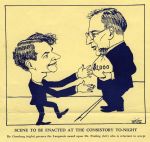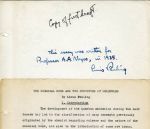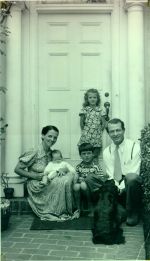
Early Years: Education, Teaching and the Chemical Bond
Page 4-3
| 1930s | Continuing crystallographic research Research notebooks Boxes 6R- 12R (Catalogue Vol. II pages 78-85) Deals mostly with crystallography and cover the years 1922-1938; some include notes added in later years. Most of the later research notebooks also include crystallographic calculations, but do not deal primarily with this research. See Catalogue for listing of research notebook contents. |
| 1930 | Quantum mechanics: "The rotational motion of molecules in crystals" A much-cited paper. Publications 1930p.7 (Catalogue Vol. I page 109) |
| 1930 | Quantum mechanics: The Structure of Line Spectra Pauling’s first book, written (through correspondence) with Samuel Goudsmit, a Dutch scientist Pauling met while in Europe. Manuscripts and Typescripts of Books 1930b2 (Catalogue Vol. 1) First edition, annotated by LP. Also, Goudsmit’s previous publication in Dutch, with handwritten note by LP on his translation. Correspondence 137.4 (Catalogue Vol. I page 263) |
| 1931 | American Chemical Society Langmuir prize The first occasion of an annual prize to the most promising young chemist in the country. Pauling was thirty years old, and had already published more than fifty papers. Pauling’s first experience of celebrity. Newspaper Clippings 1931n.2 (Catalogue Vol. VI page 1)  Satirical cartoon of Linus Pauling accepting cash as part of the Langmuir Award, Double Bond, Jr., September 2, 1931. LP Newspaper Clippings, 1931n.7 |
| 1931-1933 | "The nature of the chemical bond" The scientific work for which Pauling was most celebrated. A series of papers, beginning with Part I, his most cited paper. Pauling referred to Part I in an interview when he said, "If I were to choose for myself, I should like to be remembered as the person who discovered hybridization of orbitals (the subject of a paper I wrote in 1931)." (A Lifelong Quest for Peace) The series of papers offered principles for explaining chemical bonding where there had previously been only empirical data.
The nature of the chemical bond: |
| 1934 | Crystallography / Chemical bond: "Covalent radii of atoms and interatomic distances
in crystals containing electron-pair bonds" A widely used article. Publications 1934p.3 (Catalogue Vol. I page 110) |
| 1935 | Introduction to Quantum Mechanics with Applications to Chemistry Written with E. Bright Wilson, Jr. One of Pauling’s most cited works; remained in print into the 1960s. Manuscripts and Typescripts of Books 2.001 (Catalogue Vol. I page 263) |
| 1935 | Quantum mechanics / Chemical bond: "A quantum mechanical discussion of orientation
of substituents in aromatic molecules" A much-cited paper. Manuscripts and Typescripts of Articles 1935a.8 (Catalogue Vol. I page 155) Publications 1935p.7 (Catalogue Vol. I page 111) |
| 1935 | Chemical bond: "The Nature of the Chemical Bond" Draft of an unpublished work which Pauling’s handwritten note identifies as an essay written for A. A. Noyes. View Online: Manuscripts and Typescripts of Articles 1935a.6(Catalogue Vol. I page 155)  First draft of "The Chemical Bond and the Structure of Molecules," Linus Pauling, 1935. LP Manuscripts of Articles, 1935a.6 |
| 1935 | Crystallography: "The structure and entropy of ice and of other crystals with some
randomness of atomic arrangements" Much-cited paper; has been called the most important American contribution to the modern crystallography of water. (See p.192 of Hager, Force of Nature.) Publications 1935p.9 (Catalogue Vol. I page 111) |
| 1935-1952 | Chemical bond Chemical bond research. Science 3.003 - 3.007 (Catalogue Vol. II pages 8-12) |
| 1935 | Hemoglobin: "The oxygen equilibrium of hemoglobin and its structural interpretation" This paper, preceded by a note to Science, marks a turn in Pauling’s research activity, toward biological molecules. View Online: Publications 1935p.5(Catalogue Vol. I page 110) |
| 1936 | Hemoglobin / Chemical bond: "The magnetic properties and structure of the hemochromogens
and related substances"; "The magnetic properties and structure of hemoglobin, oxyhemoglobin
and carbonmonoxyhemoglobin." Experimenting with magnetic properties was a new way to look at hemoglobin. These papers, written with Charles D. Coryell, further established Pauling in biochemistry. View Online: Publications 1936p.3, 1936p.4(Catalogue Vol. I page 111) |
| 1935-1936 | Hemoglobin View Online: Research Notebooks Box 13R (Catalogue Vol. II pages 85-86) |
| 1936 | Chemical bond: "The structure of the pentaborane B5H9" Important paper Publications 1936p.9 (Catalogue Vol. I page 111) |
| 1936 | Chemical bond / Quantum mechanics: "The diamagnetic anisotropy of aromatic molecules" A much-cited paper. Publications 1936p.8 (Catalogue Vol. I page 111) |
| 1936 | Proteins / Chemical bond: "On the structure of native, denatured, and coagulated proteins" Written with Alfred E. Mirsky. A widely discussed and very influential paper. View Online: Publications 1936p.7(Catalogue Vol. I page 111)  Front: Ava Helen, Crellin, Peter, and Linus Pauling with Tyl Eulenspiegel, the family dog; Back: Linda Pauling, Pasadena, California, 1937. LP Photographs, 1937i.14 |
| 1937-1947 | Proteins / Molecular biology Correspondence with Alfred E. Mirsky. Correspondence 248.3 (Catalogue Vol. I page 77) |
| 1939 | Proteins: "The structure of proteins" Written with Carl Niemann. In this paper Pauling and Niemann discredit Dorothy Wrinch’s cyclol theory of a symmetrical geometry of amino acid structure, including side-to-side links, which was in competition with Pauling’s end-to-end chain theory. Publication of the paper, from which Wrinch’s career suffered, was controversial. Publications 1939p.4 (Catalogue Vol. I page 112) |
| 1939 | Chemical bond: "The electron diffraction investigation of the structure of benzens,
pyridine, pyrazine, butadiene-1,3-cyclopentadine, furan, pyrrole, and thiophene" Writen with Verner Schomaker. A much-cited paper. Publications 1939p.3 (Catalogue Vol. I page 112) |
| 1939 | The Nature of the Chemical Bond and the Structure of Molecules and Crystals: An Introduction to Modern Structural Chemistry A graduate-level introduction to the subject. Manuscripts and Typescripts of Books 1939b and 1939b2 (Catalogue Vol. I page 265) |
| 1930s-1940s | Varied researches, 1930s-1940s Research notebooks 14R - 19R, and 23R, include work from the 1930s and 1940s, work from later years, and non-research notes. Crystallography, the chemical bond and biochemistry are some of the areas covered. See Catalogue for listing of research notebook contents. View Online: Research Notebooks Box 14R - Box 19R, Box 23R (Beginning with Catalogue Vol. II page 86) |
Return to Ava Helen and Linus Pauling Papers Home
Table of Contents
- Introduction
- Ways to Approach the Curriculum
- Using Archival Materials in Special Collections
- Early Years: Education, Teaching and the Chemical Bond
- Part I: 1901-1924
- Part II: 1925-1929
- Part III: 1930-1939
- Middle Years: War Work, Peace Work and Protein Structure
- Later Years: Molecular Disease and Orthomolecular Medicine
- Topical Readings
- Websites Regarding Linus Pauling
- Appendix: General Guidelines for Use of Special Collections Materials
- Acknowledgements

